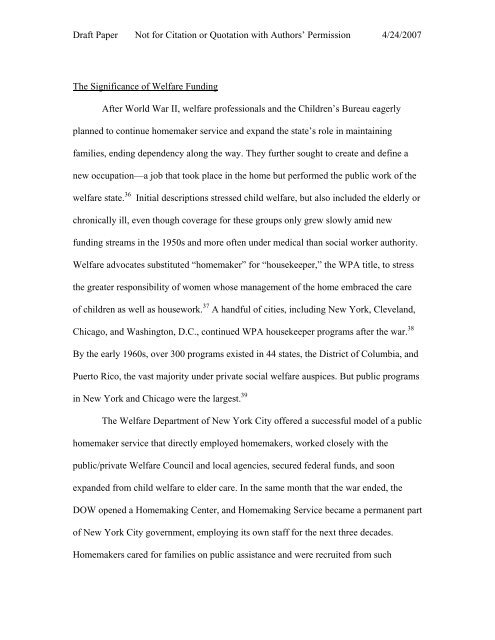Organizing Home Care: - School of Social Service Administration
Organizing Home Care: - School of Social Service Administration
Organizing Home Care: - School of Social Service Administration
Create successful ePaper yourself
Turn your PDF publications into a flip-book with our unique Google optimized e-Paper software.
Draft Paper Not for Citation or Quotation with Authors’ Permission 4/24/2007<br />
The Significance <strong>of</strong> Welfare Funding<br />
After World War II, welfare pr<strong>of</strong>essionals and the Children’s Bureau eagerly<br />
planned to continue homemaker service and expand the state’s role in maintaining<br />
families, ending dependency along the way. They further sought to create and define a<br />
new occupation—a job that took place in the home but performed the public work <strong>of</strong> the<br />
welfare state. 36<br />
Initial descriptions stressed child welfare, but also included the elderly or<br />
chronically ill, even though coverage for these groups only grew slowly amid new<br />
funding streams in the 1950s and more <strong>of</strong>ten under medical than social worker authority.<br />
Welfare advocates substituted “homemaker” for “housekeeper,” the WPA title, to stress<br />
the greater responsibility <strong>of</strong> women whose management <strong>of</strong> the home embraced the care<br />
<strong>of</strong> children as well as housework. 37 A handful <strong>of</strong> cities, including New York, Cleveland,<br />
Chicago, and Washington, D.C., continued WPA housekeeper programs after the war. 38<br />
By the early 1960s, over 300 programs existed in 44 states, the District <strong>of</strong> Columbia, and<br />
Puerto Rico, the vast majority under private social welfare auspices. But public programs<br />
in New York and Chicago were the largest. 39<br />
The Welfare Department <strong>of</strong> New York City <strong>of</strong>fered a successful model <strong>of</strong> a public<br />
homemaker service that directly employed homemakers, worked closely with the<br />
public/private Welfare Council and local agencies, secured federal funds, and soon<br />
expanded from child welfare to elder care. In the same month that the war ended, the<br />
DOW opened a <strong>Home</strong>making Center, and <strong>Home</strong>making <strong>Service</strong> became a permanent part<br />
<strong>of</strong> New York City government, employing its own staff for the next three decades.<br />
<strong>Home</strong>makers cared for families on public assistance and were recruited from such
















